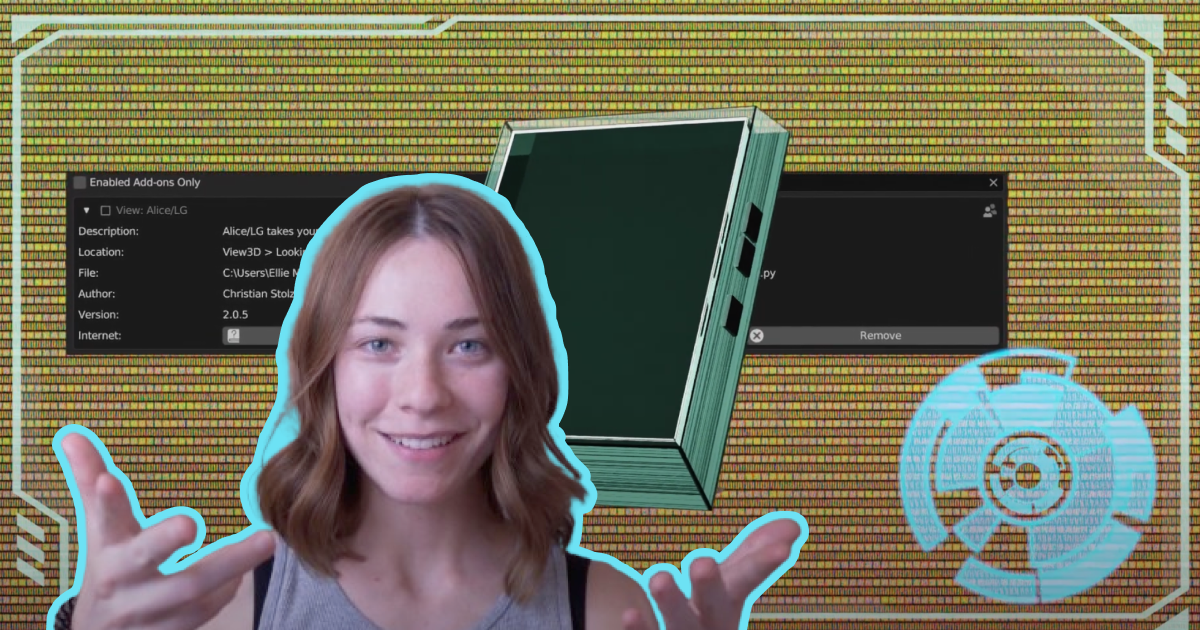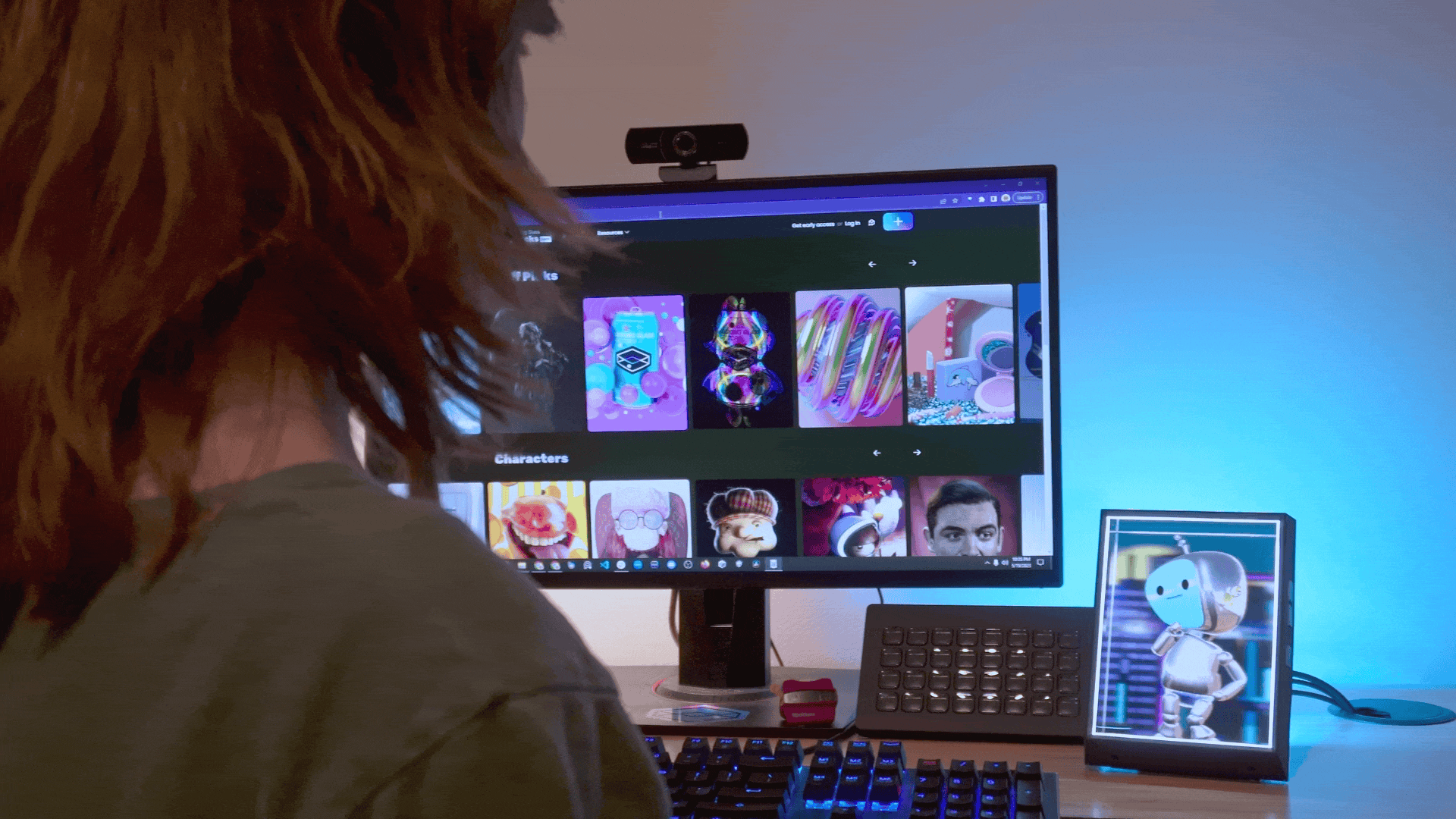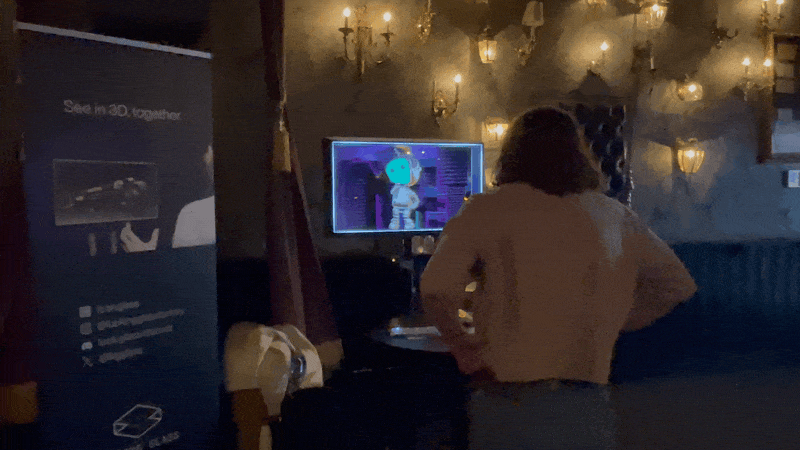Ellie MacQueen: Embracing the Holographic Canvas and Redefining Digital Art

In this interview, multimedia artist Ellie MacQueen takes us on a journey through her creative process and the transformative impact of working with Looking Glass holographic displays. From their initial awe-inspiring encounter with the technology to their groundbreaking projects like Android Andi, Ellie shares how embracing this cutting-edge medium has pushed them to grow as an artist and a creative technologist. Their insights, passion, and infectious enthusiasm make this a must-read for anyone curious about the future of digital art and the boundless possibilities of holographic storytelling.
From Ellie: Before I get started answering these questions, I just first want to say, thank you for the spotlight here! Looking Glass holograms have helped me reimagine what my art could be and how it could be shared beyond a screen <3
Briefly describe your art and the primary themes you explore through your work?
In my work, I love to focus on process.
Because I work with so many mediums, from film and digital photography and video, digital 3D workspaces like Blender, and occasionally game engines like Unity and Unreal Engine – to name a few! – the process ranges so much. Upon looking back, it is the experimentation with form that sticks out.
Some notable examples include playing with shutter speed on my Nikon FM, experimenting with proportion while modeling a new 3D character, and pushing split-tones when editing video
Pinto, one of Ellie's experiments with character design and proportion in Blender
How did you first learn about Looking Glass, and what made you decide to incorporate them into your art?
I learned about Looking Glass through X (or back then, Twitter)!
I saw a few 3D artists, mostly Blenderheads, who rendered their 3D works for the earlier 32" displays and most recently the Portrait. Immediately, I thought
"Wow! How amazing to share your 3D art in its full 3D glory!"
There is so much effort put into the three-dimensions, as well as artifacts from the 3D process, that go unseen when shared in 2D.
Can you share your initial thoughts and feelings the first time you saw your art in holographic form?
Check out more of Ellie's holograms on Blocks! https://blocks.glass/elliemacqueen
Seeing my work in holographic form was just so satisfying. I remember creating this one render where the light leaks around the moon and it was really fantastical to see the movement of that light leak within the Portrait.
How has the Looking Glass display influenced or changed your creative process?
It's really changed my process! Depth of field has a very different presence or feeling within a render on a Looking Glass compared to a 2D render.
There are techniques I've developed, like moving front and background objects closer to the focal plane, that may “cheapen” an image in 2D but enhance the image in holographic form.
What has been your favorite project or piece to create with the Looking Glass, and why?

I was lucky enough to get contracted to help make one of Looking Glass' initial Liteforms, Android Andi. This was by far my favorite experience and project to work on for the display. Having made a few unique, cute, looping animated characters for the Portrait, this was a great opportunity to push my character work even further and think more deeply about engagement, and personality traits like quirks and charisma.
Questions like: what voice can we develop that makes this android feel as human as a machine? What type of self-awareness would an android have and how would this be reflected in the way she answers questions? Why does this android exist, and why is she interesting or useful? How can this be communicated in her gestures and movement? So many questions, interesting thought experiments, and technical challenges were had!
How do viewers typically respond to your holographic art? Is there a memorable reaction you could share?

Viewers are so excited to see and interact with Android Andi. It is normally the holographic display that draws people to the installation. People usually behold her as an animation before they realize they can interact with her in real-time!
Android Andi was greeting people at Blender Conference LA, hosted by Autotroph, this spring. Andi has a southern lilt, and a southern 3D artist came up to her, and they greeted each other in the same twang. The man looked up and exclaimed, "How did she know!?" This was one of the funnier exchanges I've witnessed. People are also surprised to find that Andi can twerk a little :)
For artists new to this medium, how would you describe your experience with the technical aspects of creating for the Looking Glass?
Even though rendering for the Looking Glass is a bit of a different experience than you may be used to, it's fairly straight-forward and there are plenty of community members around to help. Looking Glass supports in-software rendering for not only Blender, but Unity and Unreal Engine. It's pretty handy to be able to see your workspace in real-time using these tools, even before rendering!
For artists who are looking to use the Looking Glass for their work, what are you waiting for? I would start out experimenting with Looking Glass' browser-based Blocks, which can help an artist preview their work in an embeddable, web-friendly holographic format.
Are there any projects you're particularly excited about creating with the Looking Glass in the future?
There are so many projects I'm excited about creating with Looking Glass in the future! I'm particularly interested in continuing to explore interactive installments in Unity and Unreal, or even Touch Designer.
What's cooler than a hologram? An interactive one!
How has the Looking Glass community or support team contributed to your experience as an artist?
The Looking Glass community has been amazing. Arturo, Bryan, and Alec in particular have been especially helpful in helping me achieve the most cinematic and compelling renders when I had just started rendering for the Portrait.
What would you say to someone who's intrigued by this medium but hasn't taken the leap to try it yet?
Intrigue is a sign to investigate further!
Come to a meetup sometime and ask any questions you may have. There are a lot of folks excited to help.
Which feature(s) of the Looking Glass do you find most beneficial for your work and why?
The most beneficial feature for my work is probably AliceLG, the Blender Looking Glass add-on, because it allows me to see my workspace on the display in real time. This can be super helpful for blocking out a scene and staying true to a fluid, and intuitive workflow.
Another great feature is Blocks because if I'm away from my device it can help me visualize what adjustments I need to make in a render for this medium in particular.
How do you feel you've grown as an artist since you started working with holographic displays?
It's helped me grow so much! I'm more technically proficient than before, more curious about how I can develop my own hardware and augment Looking Glass hardware to create a more compelling final piece. It's been invaluable to my growth as a creative technologist.
Where can readers find more of your work or follow your work?
Here's my linktree: https://linktr.ee/elliemacqueen, and my 3D Instagram is @dangitdigital!
We hope you're enjoying our artist features!
Are you an artist working with Looking Glass and want to share work with us? Write to us at future [at] lookingglassfactory.com.
We want to shine line on anyone in our community using Looking Glass or any 3D adjacent technology to build worlds in an entirely new medium (and dimension)!
